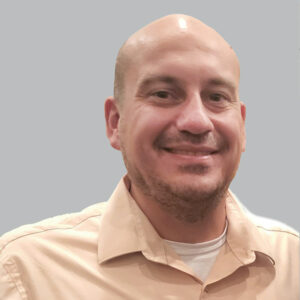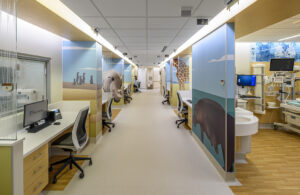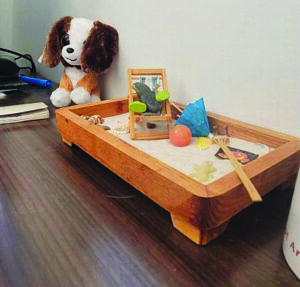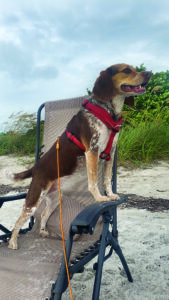 The principal at Champlin Architecture in Cincinnati talks about his parents’ influence on his career path, appreciation for teamwork in everything from project teams to TV shows, and new pandemic-inspired work habits.
The principal at Champlin Architecture in Cincinnati talks about his parents’ influence on his career path, appreciation for teamwork in everything from project teams to TV shows, and new pandemic-inspired work habits.
What drew you to a career in healthcare design?
My father works in architectural design, so at a very early age I started developing a passion for architecture. At just three years old, I remember sitting next to my dad at his drafting table, drawing up houses for all of my family members. My mother was a nurse for many years, so I also grew up hearing and seeing a lot about the healthcare world. My siblings and I all followed our parents’ footsteps, with me in architecture and my two brothers in healthcare.
During my first healthcare project at Champlin Architecture in 2004, I knew right away it was a project type that I would enjoy focusing on. Today, I continue to learn and enjoy the challenges that come with a rapidly (and constantly) changing world. I’ve been fortunate to partner with clients that are amazing to work with. It’s less like work and more like having fun with what we’re able to provide.
What was your first healthcare project and what lesson from it do you still carry with you?
Renovation to relocate a cardiovascular recovery unit and radiology department as part of a master plan. I learned the importance of visiting a project site early in the design stage. It’s not only a chance to measure existing conditions, but also to observe, noting the paths that people take to get supplies or move from one task to the next. I take that information back to the drawing board when laying out the new space to improve the workflow and human experience. It’s a great way to learn how an organization operates.
Three recent healthcare design projects and your role
- The Christ Hospital Health Network, NICU renovation, Cincinnati, principal and lead healthcare designer.

- The Christ Hospital Health Network, electrophysiology department relocation (currently under construction), Cincinnati, principal and lead healthcare designer.
- Bon Secours Mercy Health Anderson Hospital, emergency department renovation, Cincinnati, principal and lead healthcare designer.
What do you like best about working in healthcare design?
If I must pick one thing, I’d say it’s the interaction with the client—the users. Being able to truly listen to what the needs are and then develop a design that improves the lives of the staff, patients, and the visitors is the best feeling. Over the past couple years, I’ve started changing the design during a client/user meeting and incorporating suggestions as they are shared (working in Revit and presenting in Enscape). The engagement that occurs with the stakeholders is truly amazing.
What challenges about your work keep you up at night?
Providing what everyone wants but staying within budgets. The more pieces that are in the puzzle, the more determined I get about finding a solution and making it all fit. We’re also all dealing with the supply-chain issues and the massive increase of construction costs, so, of course, we’re working our way through those challenges, as well.
 An unexpected item on your desk …
An unexpected item on your desk …
A mini-Zen garden. I have two of these at my desk, one is an oriental-style garden and the other is beach themed. Once in a while you just have to take a Zen break!
Outside the office, we’ll likely find you …
At home with my wife and pets or at the pool. Or even better, at a beach somewhere, if I have a chance to take a trip (hence the beach-themed Zen garden on my desk).
What’s a new habit or hobby you’ve picked up during the pandemic?
It’s kind of odd, but I don’t sit at my desk in the office that often. Working from home during the pandemic, I got used to working wherever I am, as long as I have internet. Since then, even when I’m in the office, I sit wherever my team is sitting. What’s great about that is that we get into this kind of collaborative “flow.” I get a lot of good-natured teasing about this, too. (“Looking for Mike? Look anywhere except his desk.”)
 Dog or cat?
Dog or cat?
Don’t tell my cats, but dogs. My dog, Heidi, is so precious and spoiled rotten!
Coffee or tea?
Sweet Tea. I enjoy both as well as hot tea. Being from the South, sweet tea is what they put in our baby bottles!
Morning person or night owl?
Night owl all the way. I struggle in the mornings, and my clients will tell you I do my best work at night.
Fashion trend you think should make a comeback
Zoot suits. I’ve always liked them with the pop of color and lively design.
How did you make your first dollar
Bussing tables at a restaurant in Virginia.
First music album you ever bought
“Paul’s Boutique,” by Beastie Boys. I think I was about nine years old and my two (much) older brothers may have had something to do with my early exposure to the best that ’80s and ’90s pop culture had to offer. Oddly enough, this album is currently in my car (but I had to upgrade from cassette tape to CD).
Cocktail of choice
It used to be Bourbon, but these days I stick to seltzer water.
Your hidden talent
I can play the sounds of a trombone with just my lips. I played trombone in high school and it’s one of those things that I picked up then and can still do today.
Favorite …
Quote “The details are not the details. They make the design.” —Charles Eames. Everybody in this industry can relate to this idea: that the details can make or break the entire aesthetics. In healthcare especially, with the precision required on medical equipment, details are extremely important. Some may think there’s a risk in too much detailing, but I respectfully disagree. There has to be certainty, and in my experience more details make for a better the outcome.
Additionally, the more we’re able to collaborate between owner, architect, vendors, contractors, and all involved that becomes very visible in the workmanship and in the gratification noticed in those that make the vision come to life. And in healthcare, what fascinates me is the ability for us to collectively make this vision come to reality—something that starts on paper can become something real, that transforms and even saves lives.
Movie character Michael Corleone in “The Godfather.” What a way to show how to stay calm and collective in chaotic situations. It’s one of those things I’ve learned over the years with project deadlines is to stay calm (or try to) and don’t panic.
Show to binge watch “Ted Lasso.” It’s absolutely amazing. I love how it shows the importance of having a team effort in everything we do in life.
Band/musical artist Wu-Tang Clan. I grew up listening to the band from the early ’90s. To this day it’s a work of art in my view. Each member brings something unique and brilliant to the group, and they blend it all together with the instrumentals by the RZA—the result is just very powerful. To me it’s another great example of a well-orchestrated team working together to develop something that’s genuinely exceptional.
Guilty pleasure Energy drinks. They replaced my coffee.
Snack when you travel Hot boiled peanuts. This is something I get when I go home because I can’t find them in Cincinnati.
Sport Skateboarding. I skated for about 12 years from the time I was eight years old. I still have a skateboard and occasionally I try to do some tricks. Amazingly, I still have a few up my sleeve!
Book “Pillars of the Earth” by Ken Follett. The story is great, of course, but I’m also fascinated by the author’s personal journey and how he came to realize that today’s ancient (or even ruined) cathedrals are very much alive. More importantly, these giant structures are storytellers, if you know where to look. They can speak for the “dirt-poor hovel-dwellers” who dreamed of constructing something high enough to reach Heaven without having even modern geometry (or paper and pencil, for that matter) among their tools. And these early builders knew that they’d never live long enough to see their vision completed, but they began the generations-long journey anyway. But that’s what we’re all trying to do, right? Build something incredible that’s meaningful to people, with the hope that it will outlive us.
City to visit Charleston, S.C. I’m originally from a small town in the mountains of Virginia. My family and I moved to Charleston, where my parents still live today. I say I’m from Charleston, as it feels like home to me and is such a beautiful area and has the kindest people. The history and the architecture are remarkable and, like the cathedrals in “Pillars,” they also have stories to tell.











